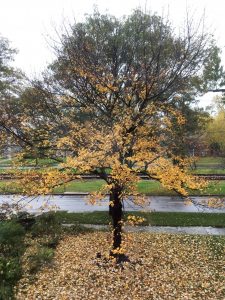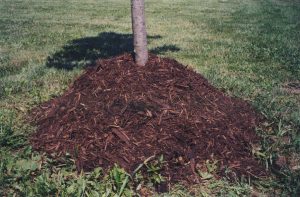
Acer ‘Celebration’ with half of its leaves on the tree and the other half on the ground

Acer palmatum ‘Viridis’ fall color
This has been a crazy, extremely wet year. We all keep waiting for color change on our trees but it has been very slow in coming. The honey locusts turned yellow a few weeks ago. My Celebration Maple, usually turns bright orange in early October and has lost all of its leaves by mid-October.This year, it had all its leaves which are merely golden yellow until the rain knocked half of them off. Two days ago, my Japanese maple, Acer palmatum ‘Viridis’, finally turned bright orange and I noticed this morning that my Paperbark Maple, Acer griseum, is starting to color.
n the past few years, our trees have been subjected to incredible stress: a year of extreme moisture followed by a year of drought followed by another year of more moisture than usual. Although trees are dormant during the winter, exposure to tough conditions can cause more stress. Obviously, therefore, you want to do what you can to minimize that stress.
The International Society of Arborists makes the following recommendations for preparing trees for winter weather:

Do not do THIS!
Rely on mulch. Put an inch of composted organic mulch (double-shredded hardwood bark, not cypress) under your tree in the fall or early winter to help retain water and reduce temperature extremes in the soil. This thin layer of mulch will act like a blanket and give the tree’s roots a little extra protection. Do not overmulch. Nothing drives me crazier than seeing a volcano of mulch around a tree trunk, particularly when it is laid up against the trunk. This condition engenders just the right conditions for disease and insect infestation because it keeps moisture on the bark. Too much mulch also creates an anaerobic environment that then produces a repellent smell.
Give your trees a drink. Winter droughts require watering as much as summer droughts. If temperatures permit, an occasional watering during the winter on young trees can be a lifesaver. But be sure to water when soil and trees are cool but not frozen. We frequently get a warm spell during the winter. Hopefully, it will last at least a week, giving the soil a chance to thaw. If the ground is still frozen, water will run right off. This may not be as much of a problem this year since fall has been relatively wet (I’m beginning to wonder if it will ever stop raining; I still have more bulbs to plant).

Wire cage prevents animal damage to young tree trunks
Prevent injuries. Branch breakage or splitting can be caused by ice and snow accumulation or chewing and rubbing by animals. You can prevent such problems with young trees by wrapping their base in a hard, plastic or wire guard or a metal hardware cloth. Wrapping trees with burlap or plastic cloth also can prevent temperature damage. However, it is important to remember to remove the wraps and guards in the spring to prevent damage when the tree begins to grow.
Other damage can be caused when plowing or shoveling snow. Being mindful of trees nearby is crucial. Damage to limbs and trunks from plow blades or a sharp shovel can make trees susceptible to insects and diseases in the spring. One way to avoid such damage is by ensuring that trees are planted away from driveways and sidewalks. If you are concerned, push tall, colorfully painted stakes into the soil in front of the tree. When the snow is deep, they stakes will be quickly seen even if the tree trunk isn’t.

Structure of Japanese maple seen in late fall, winter, and early spring
Prune your trees. Late Fall is a good time to prune trees. Not only are trees dormant in the colder months, but it is also easier to see a tree’s structure when there are no leaves on the branches. Another good time to prune is very early spring before foliation; that is when I usually prune my Japanese maple. Proper pruning removes dead or dying branches that are likely to fall on roofs or vehicles in the driveway. Be aware that each tree is different, and pruning at the wrong time or the wrong way can injure a tree. A certified arborist will be knowledgeable and hopefully, also artistic. Winter rates are usually lower. If you need the name of a good arborist, I can recommend someone to you.
Enjoy the color that is finally coming and pray for a bit of sunshine.


0 Comments